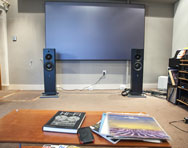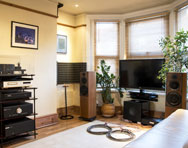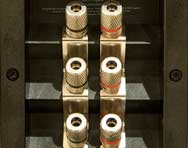Click
an image to enlarge.
6 November 2019 -
With the change of the seasons comes possible changes in loudspeakers.
The second set of replacement panels supplied by MartinLogan lasted
only seven months before displaying signs of near death…
A HUGE thank you to everybody
who responded to my ‘Joy
& Pain’ diary of MartinLogan ESL issues (MartinLogan
Owner Scenario Owner Experience 1) earlier in the year. The
response from owners as well as other speaker manufacturers was
interesting and varied. MartinLogan definitely have loyal fans,
who it appears do not want to read, or hear a bad word against
MartinLogan ESL’s . All MartinLogan owners have one thing
in common ‘We love the natural open sound and three
dimensional sound quality of the MartinLogan ESL’.
However, many of us have encountered similar breakdown issues,
but at least some owners have received a better quality of service
‘generally’ outside of the UK. I am hoping the change
of distribution & support network to PMC will mean we all
receive a high quality service if (and when) we encounter issues.
After contacting MartnLogan to
inform them of the recent panel failure, Scott Gribble (MartinLogan
Service Manager) advised he would organise for a ‘third
set of replacement panels to be manufactured, he confirmed the
wait time of around 8 – 12 weeks. Unfortunately, I have
lost confidence in the panel reliability. It is now time for me
to seriously look for another pair of loudspeakers. Obviously,
this will be a difficult journey. The longlist began with the
following;
Golden Ear Triton 2 /
3 (£4000) Magico, JansZen Valentina zA2.1 Floorstander (£8000),
Magico (£Expensive)
Focal Aria 926 (£1800), Focal Kanta No2 (£7000) Focal
Sopra N2 (£10000)
& the Dali Rubicon 6 (£2999)
After further investigation I
quickly established the Golden Ear Triton range would not suit
my needs and the Magico range (though lauded) were way out of
my reach (just as is a date with Jennifer Lopez). I was able to
listen to a pair of the beautifully designed JansZen Valentina
ZA2.1 ESL’s, earlier in the year, however, it was very difficult
to judge the full capability of this speaker due to the limited
‘streaming only’ set-up in the owners’ home.
. I was intrigued by the initial ‘hint’ of a natural
and open sound created by the JansZen’s and may attempt
to further explore the possibility of listening with my own set-up
at some point in the future?
Though I was never overly impressed
with any Focal loudspeaker at the h-fi shows I attended to date,
I felt impelled to lend them another ear (or two) due to the many
recommendations from trusted viewers. At this point it is important
to stress that I always recommend a home demo of any hi-fi
component (for many reasons). Particular component choice
such as amplification interconnects, source and room characteristics
obviously play a major factor on outcome, but I felt I could at
least get a flavour of any speaker characteristic (if any) from
a showroom demo situation before making the next home demo step.
My favoured source is vinyl, so I set-out with various well played
jazz, classical and up-tempo albums ready to spin. We are all
aware our ears, taste and expectations are different, therefore,
the intention of the below brief noted experiences are not meant
as an individual ‘loudspeaker critique’. I will save
such energy for the final loudspeaker choice (if any). I have
however previously mentioned ‘the natural open sound
quality of the MartinLogan ESL’, so, with this in mind,
you should get an idea of the type of experience I am hoping to
achieve!
I
was able to set up a demo of the Focal Aria 926 and Focal
Kanta No2 models at a local hi-fi chain in South London.
Unfortunately, I was still unimpressed with either model so did
not feel impelled to progress to exploring the higher priced Sopra
N2.
Slightly
dejected, thankfully, I only had to walk a few metres across the
road to my next arranged demo. Though the outlet only had the
Dali Rubicon 5 in stock and the salesman could
not set up the only turntable in the store (Technics SL1210) due
to a damaged cartridge, at least I could again get just a flavour
of the Dali award winning design via TIDAL streaming. Now, this
short demo proved the Dali design was a ‘clear room filling
experience’ worthy of further exploration.
Further exploration has now led
me to include the below speakers to the shortlist.
Dali Rubicon 6, Epicon 6 and Audiovector QR & SR range
Mid November through to December
is always a positively busy time for me. The London Jazz Festival
allows me to completely immerse myself into the great jazz musical
tapestry. Venues such as the Royal Festival Hall, Cadogan Hall,
Barbican Centre and PizzaExpress Jazz Club (to name just a few)
will host some of the best musical performances of the year. I
always tune into my favourite artist performances as well as the
photography aspect of the festival. At this point I was also especially
drawn to the artist sound-checks and the communication between
the musicians and sound engineers. Musicians asking for “more
cymbals in their monitors…”, “less volume on
their microphone…”, or a specific saxophonist
requesting “less of a shrill sound…”
from his sax. Listening to such communication certainly hit home
with regards to the possible control a sound engineer has at his
fingertips and the connection with regards to what the listener
may (or may not hear)? I returned home each night and occasionally
played specific vinyl recordings of compositions by the musician
he or she performed that night. Of course, these recordings will
differ in delivery, mood and sound quality for obvious reasons,
but these experiences, as well as the experiences I have encountered
in recording studios assist in fine-tuning my ears.
With the above in mind, once the
London Jazz Festival was over, I quickly set about arranging for
the delivery of Audiovector QR 5 & SR 3 Avantgarde floorstanders
to start with. I reiterate, this shared experience is not intended
as an in-depth speaker review, until (if) a particular pair of
loudspeakers are chosen as a replacement for my MartinLogan Scenario
ESL’s?
The
Audiovector SR 3 Avantgarde’s
were placed in the same footprint as my beleaguered MartinLogan
Scenario ESL’s. Within a few seconds of vinyl playback I
did comment positively to a colleague sitting closely regarding
the clarity of the high frequencies, however, after ten minutes
of varying speaker positions, I removed them and replaced them
in their boxes. I could not recreate “the natural open
and three dimensional sound quality….” I am used
to hearing.
cr.jpg) |
“The
QR 5 is now the biggest speaker in the QR series and by far the
best performer…” –
Audiovector. The white QR 5’s certainly stood out amongst
my black components. Obviously if these were going to be the replacements
for my MartinLogan ESL’s I would need to beg for a pair
in black ash! First impressions were… They definitely sound
more relaxed than the higher priced SR 3 Avantgarde’s, higher
frequencies were again delivered with clarity through the lauded
gold leaf air motion tweeter (AMT). Overall the musical delivery
was smoother and more cohesive than the SR 3’s. Bass definition
and depth was also good, but overall musical depth, imaging and
transparency was still not a patch on the MartinLogan ESL’s.
Time to move on...
cr.jpg) |
After
the home demo of the Audiovector SR 3 Avantgarde and QR 5, I decided
to save my aching back and return to assessing ‘the flavour’
of my next chosen speaker from a comfortable South London demo
room. The Neat Acoustics Momentum SX5i’s (£4250)
were the first floorstanders to be placed in front of me. Unfortunately,
this outlet did not receive my determined hurried morning message
advising of “vinyl being my choice of sources…”
So I had to contend with a few minutes of a hurried swap from
a very capable Moon 390 streaming preamplifier… Actually,
this was not too painful. I was struck by the smooth and easy
delivery of high frequencies through the Momentum’s! After
changing sources to a Rega Planar 8 turntable, I continued listening
with John Coltrane’s “My Favourite Thing” and
Abdullah Ibrahim’s “Water From An Ancient Well”
albums. These albums will challenge any systems’ higher
frequencies, timing and musicality. Again, higher frequencies
were delivered with ease and smoothness. However, midrange and
lower frequencies were not as rich and cohesive as I would have
hoped for from the SX5i’s isobaric bass unit and dedicated
rear-firing port. Obviously, I could have experimented further
with positioning? AND the PMC Cor amplification (though trusted
and revered) was not my preferred choice. However, I decided to
move on and hear what the ATC SCM40 Active’s had to say
for themselves…
.jpg) |
ATC
monitors are revered in the recording studio environment (rightly
so). I have had various discussions with sound engineers at various
venues during this years’ London Jazz Festival regarding
the viability of using ‘the right’ ATC speaker in
my more ‘homely’ listening room environment. I was
relieved to be able to stay seated on the comfy listening sofa
as each 36kg ATC SCM40A (£6800) unit was
carefully manoeuvred into position onto granite slabs. As these
are active speakers, they only needed to be connected to the Moon
390 streaming preamplifier, allowing for each of the three dedicated
built in speaker amplifiers (one for each driver) to run under
their own steam (so to speak). Due to ATC’s reputation,
my expectations were very high! Thankfully, these speakers did
not disappoint. As soon as the needle touched down onto the record
I got a sense that I was about to hear something special…
 |
Steve
Davis’ bass, Elvin Jones’ drums, McCoy Tyrner’s
piano coupled with John Coltrane’s soprano sax on the track
“My Favourite Things” (from the same titled album)
arrive with a commanding rhythmic drive, insisting you stop what
you are doing and pay attention! These speakers clearly deliver
music in a muscular controlled fashion. Continued listening also
confirmed their tonally accurate highs, mids and lows.
Obviously this was an impressive
start and I continued to test the ATC SCM40’s at various
volume levels to hear if their tonal qualities and musicality
would change in any shape or form. Transparency and the ability
to deliver musical depth was also part of my criteria? I also
wanted to know if I would feel fatigued due to their accuracy.
So far so good at high to medium levels, though, of course, this
was not a lengthy, or home listening experience. Requesting a
home demo was the next step.
The ATC SCM40A (£6800)
speaker is also available as a passive (£3750)
speaker. As I am accustomed to the transparent qualities of my
M8-500S power amplifier & M8PRE preamplifier, it was important
to discover which speaker option would work best in my home environment.
I therefore requested a home demo of both speaker models…
The
ATC SCM40 passive speakers were
delivered (direct from ATC) 16 January 2020. Interested on-lookers
peered quizzically as UPS couriers wheeled the miniature coffin
shaped trusty Sigma flight cases through my front door into my
living room.
My initial rushed set-up and
quick listen highlighted the importance of insuring you stick
to specific set-up protocol and detail - such as ‘speaker
floor spikes’. ATC neglected to include the floor spikes
in the packaging, but I thought I would ‘give the speakers
a go’ without them. I can now confirm… listening to
the SCM40’s without their isolating floor spikes is akin
to watching your television thorough a netted curtain. Thankfully,
the floor spikes were delivered the following day so normal service
resumed!
Due to my long-time MartinLogan
ESL experience, my immediate instinct was to place the SCM40’s
in a ‘toed in’ position. The mushy presentation and
soundstage suggested I should readjust. Once I placed the speakers
in the straight-ahead position, I could hear most of what I experienced
from the Active range during the showroom demo.
 |
As
I listened to various albums on CD as well as vinyl from morning
through to night… then morning again, I found my listening
experience was different than with my MartinLogan ESL’s.
I found my listening, but my thoughts and feelings had become
more analytical. ‘YES, this is what I set out to do and
is a normal process when introducing new components or cables
into your system!’ BUT, I expect to be able to switch from
‘analytical listening to emotional’ within a relatively
short time after set-up. To me, this analytical to emotional switch
is a good indication to suggest I have made the right choice (and
what I experienced with my MartnLogan Scenario ESL’s when
I introduced them into my home nearly twenty years ago). This
is not a complete negative assessment of the ATC SCM40’s
and at least my lengthy listening periods proved these speakers
were not fatiguing. I feel it is important to add, during this
listening experience, I used three different speaker cables. My
original Chord Legend, Chord Epic and Russ Andrews 8TC speaker
cable. With the Russ Andrews 8TC speaker cable in line, my analytical
side was slightly tamed, but overall, it never disappeared completely.
Overall, I enjoyed my experience
with ATC SCM40 passive speakers. I did not get that ‘I
cannot move from my listening chair’ feeling, or ‘only
call me if you can offer me the key to Jennifer Lopez, or Halle
Berry’s bedroom’ feeling when listening to music
with them. I missed the emotional & spiritual connection I
feel when my MartinLogan ESL’s are in place. This is not
a criticism of the ATC SCM40’s in any shape or form. In
discussion with friends and colleagues I am reminded of ATC’s
studio monitor heritage! I am clearly addicted to the ESL large
holographic three-dimensional soundstage. I also miss the detail
and musicality I get from my ESL’s at low volume.
 |
As
I viewed my faulty MartinLogan Scenario ESL’s perched in
the corner at the other end of my room, I did actually consider
the possibility of purchasing the ATC SCM 40’s, as well
as considering various amplifier driving options for them. (Which
just might bring me closer to my dream)? The SCM 40’s can
be tri-amped. However, I could consider utilising two amplifiers
(one amplifier for bass and the second for midrange and tweeter
drive units). Or, I could just purchase the Active version of
this speaker and utilise my balanced Musical Fidelity M8 preamplifier
for control only?
The ATC SCM40 passive (and active)
speakers are extremely accurate and capable performers, but perhaps
I am just too old and set in my musical ways to change to conventional
cone speakers? I decided against a home demo of the active model
as I felt I needed to move up the ATC range perhaps? During the
above listening experience, listening to music using the SCM40
has certainly sparked my interest in ATC speakers generally. Perhaps
ATC will allow me to explore other speakers they have in their
range?
18 February 2020 –
The third set of replacement panels for my MartinLogan Scenario
ESL’s were finally delivered. I fitted the new panels within
an hour and sat back in my listening chair to enjoy. Even though
these new panels require several hours to run-in, I will admit
it was great to get back to that trademark natural open and three
dimensional sound quality, however, after waiting several weeks
for the new panels to run-in, I realised another problem plagued
my system…
Musical
Fidelity M6 PRX Power Amplifier Experience review...
Thank you to Erik from Premium
Sound HI FI & Audio Equipment & ATC for their assistance
throughout this experience.
Complete system details:
Turntable
AMG Viella V12 turntable with AMG Teatro MC & AMG reference
tonearm cable
Phono stage & interconnect cables. Whest PS.40RDT Special
Edition phono stage
with Russ Andrews Timbre XLR interconnect cables
CD player
Musical Fidelity A3 CD player (internally upgraded). Van Den Hul
The Second Analogue Interconnect cables
Amplification
Musical Fidelity M8-500S power amplifier with Musical Fidelity
M8PRE preamplifier
Luminist Revision Poseidon XLR balanced cables
Speakers
ATC SCM40 passive speakers.
Chord Legend speaker cable, Chord Epic speaker cable & Russ
Andrews 8TC speaker cable.
REL S3 subwoofer in photograph (but not in use for this
experience)
Table
Quadraspire Q4 EVO turntable wall bracket. Quadraspire Q4 EVO
4 tier shelf
Power & mains cables
Russ Andrews BMU 3000, Michael Valentine Studio Silver Gold Special
Edition BMU
Powerkord 300 mains cables for BMU, amplifier & preamplifier
Robin Francis
© Michael Valentine Studio
November 2019 – March 2020
Further
Recommended
Viewing
|
Use the links below to continue to the Musical
Fidelity M6 PRX (M6s PRX)
Power Amplifier Experience Review,
or go back to the MartinLogan Scenario Owner Experience one,
or
visit the MartinLogan Impression ESL11A panel & bias power
supply replacement page...

